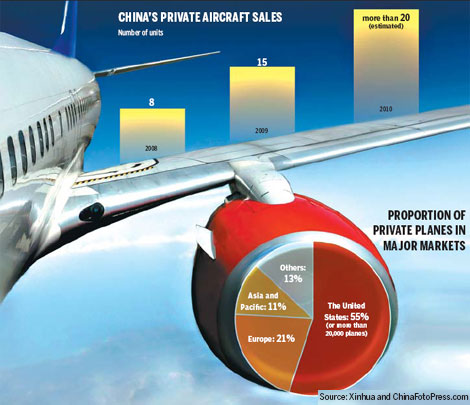Companies
Sky's the limit for privately hired aircraft
Updated: 2011-04-18 10:25
By Xin Dingding (China Daily)

Number of planes expected to soar as restrictions end
BEIJING - Low-altitude airspace will be opened for private flights in five to 10 years but industry insiders are reluctant to predict how many will be taking advantage of it, although they agree numbers will shoot up.
"You should just let your imagination soar," said Zhang Hongbiao, director of the science and technology committee of the Aviation Industry Corporation of China, the country's major aircraft maker.
|
||||
Meng Xiangkai, president of China Aviation Industry General Aircraft Co Ltd (CAIGA), agreed with Zhang. He said: "When you review forecasts for China's automobile market over the past years, it's impossible to find a correct one. Usually, actual demand was several times larger than the predicted number. It will be just the same with China's general aviation aircraft market."
Latest policy
The confidence stemmed from a circular issued in the second half of last year by the State Council and the Central Military Commission that promised to gradually relax restrictions on low-altitude airspace (below 1,000 meters) within the next five to 10 years. The circular said, "Pilot projects will be carried out nationwide between 2011 and 2015 and the reform (on low-altitude airspace management) will be deepened between 2016 and 2020".
Last month, Li Jiaxiang, head of the Civil Aviation Administration of China (CAAC), was more precise. He said the low-altitude airspace will be totally opened up by the end of the 12th Five-Year Plan (2011-2015) period.
Following pilot projects carried out in Jilin and Heilongjiang provinces in Northeast China and Guangdong province in South China last year, trials will be expanded to Central China's Hunan and Hubei provinces, South China's Guangxi Zhuang autonomous region, and the eastern part of the Inner Mongolia autonomous region in North China this year, he said. Hainan province started reforming its airspace restrictions below 1,000 meters in January.
According to Outlook Weekly magazine and other media reports, the ongoing pilot projects involve trial flights across a pre-determined region to investigate local airspace and flight routes and look for possible spots for landing and taking off.
With the information and data in hand, the authorities review existing laws and regulations concerning low-altitude airspace, draft new rules to better manage the airspace, and embark on research on how to provide necessary services.
There were 1,010 small aircraft registered on the mainland at the end of 2010. The United States, the world's largest general aviation market, has more than two thirds of the world's total 330,000 general aircraft.
Industry insiders used to attribute the reason for general aviation's slow development to the management of airspace. In China, it is under the control of the military. A recent report on Xinhuanet.com said that only a number of air routes and very limited airspace are in the hands of the CAAC. Even then, general aviation aircraft pilots cannot take off without going through bureaucratic procedures. They need to report their every movement to the military for approval, a task that usually takes at least half a day to accomplish.
But things will change for the better after the gradual opening of airspace below 1,000 meters. At an international air show this year, Wang Changshun, deputy head of the CAAC, said by 2015 China's general aviation fleet would at least double its current size to 2,000, with an annual growth rate of 15 percent. The flight hours of general aviation aircraft will reach 280,000, with an annual growth rate of 16 percent.
Specials

In the swim
Out of every 10 swimsuits in the world, seven are made in China.

Big spenders
Travelers spend more on shopping than food, hotels, other expenses

Rise in super rich
Rising property prices and a fast-growing economy have been the key drivers.



